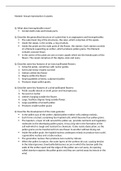Module: Sexual reproduction in plants:
Q: What does hermaphrodite mean?
Contain both male and female parts.
Q: Describe the generalised structure of a plant that is an angiosperm and hermaphrodite:
The outermost ring of the structures, the calyx, which comprises of the sepals.
Inside the sepals, is the corolla, a ring of petals.
Inside the petals are the male parts of the flower, the stamen. Each stamen consists
of a filament supporting an anther, which produces pollen grains. The filament
contains vascular tissue.
In the centre of the plant are one or more carpels which are the female parts of the
flower. The carpel comprises of the stigma, style and ovary.
Q: Describe some key features of an insect-pollinated flowers:
1. Colourful petals, sometimes with nectar guides.
2. Scent and nectar (mainly sucrose)
3. Anthers within the flower
4. Stigma within the flower
5. Small quantities of sticky, sculptured pollen
6. Produces larger pollen grains.
Q: Describe some key features of a wind-pollinated flowers:
1. Petals usually absent or small, green and inconspicuous.
2. No scent or nectar.
3. Anthers hanging outside the flower.
4. Large, feathery stigmas hang outside flower.
5. Large quantities of smooth pollen
6. Produces smaller pollen grains
Q: Describe the development of the male gametes:
In the pollen sacs of the anther, diploid pollen mother cells undergo meiosis.
Each forms a tetrad, containing four haploid cells, which become four pollen grains.
The tapetum, a layer of cells around the pollen sac, provides nutrients and regulatory
molecules to the developing pollen grains. It has a big role in the formation of the
cell wall which is tough and resistant to chemicals. It also resists desiccation, so the
pollen grains can be transferred from one flower to another without drying out.
Inside the pollen grain, the haploid nucleus undergoes mitosis to produce two nuclei,
a generative nucleus and a tube nucleus.
The generative nucleus then produces two nuclei by mitosis.
When the pollen is mature, the outer layers of the anthers dry out, causing tension
in the lateral grooves. Eventually dehiscence occurs in which the tension pulls the
walls of the anther apart and the edges of the pollen sacs curl away. An opening
called stomium exposes the pollen grains and they are carried away by insects or the
wind.
, Q: Describe the development of the female gamete:
The ovary contains one or more ovules.
In each ovule, a megaspore mother cell, surrounded by cells of the nucellus,
undergoes meiosis making four haploid cells.
Three disintegrate.
The remaining cell undergoes three rounds of mitosis, producing eight haploid
nuclei.
Two of the haploid nuclei fuse to make a diploid nucleus called the polar nucleus.
The 6 remaining haploid nuclei form 3 antipodal, 2 synergids and 1 oosphere.
The nuclei are in the embryo sac, surrounded by the nucellus, a layer of cells which
provide nutrients.
Around the nucellus, are two layers of cells called the integuments, the gap between
the integuments is called the micropyle.
Q: What is pollination?
The transfer of pollen grains from the anther to the mature stigma of a plant of the
same species.
Q: What is self-pollination?
The pollen from the anthers of a flower is transported to the mature stigma of the
same flower or another flower on the same plant.
Q: What is cross pollination?
Pollen is transferred from the anthers of one flower to the mature stigma of another
flower on another plant of the same species.
Q: What are the genetic implications of self-pollination?
inbreeding
Self-fertilised species depend only on crossing over, independent assortment and
mutation to produce genetic variation. Therefore, they display less genetic variation.
There is a greater chance of two potentially harmful recessive alleles being brought
together at fertilisation.
An advantage of in breeding is that it can preserve those successful genomes that
are suited to relatively stable environment.
Q: What are the genetic implications of cross-pollination?
Outbreeding combines gametes from two individuals, in addition to events in
meiosis and mutation, and so it generates more genetic variation than inbreeding.
Outbreeding reduces the chance of producing potentially harmful allele
combinations.
Outbreeding is of great evolutionary significance because in the struggle for survival,
some genomes are more successful than others.




